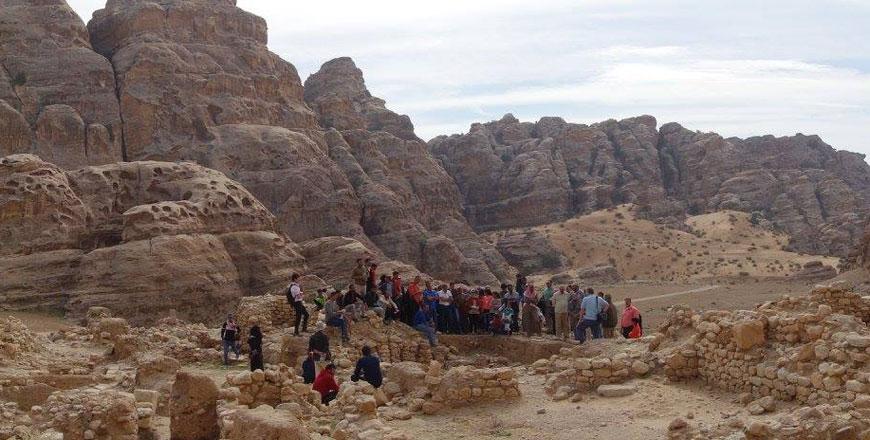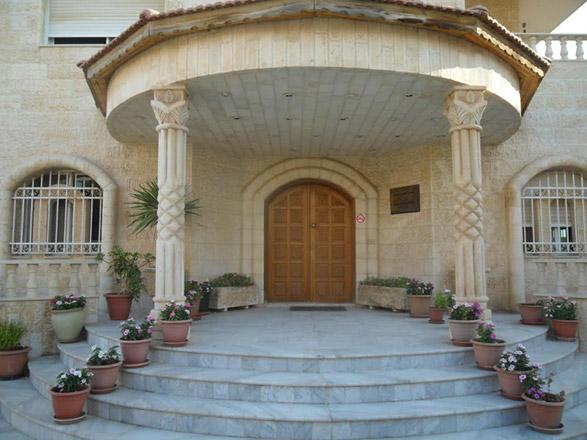You are here
Project connects local communities of Basta, Beidha villages to their ‘rich heritage’
By Saeb Rawashdeh - Dec 21,2016 - Last updated at Dec 21,2016

The ‘Deep Past as a Social Asset in the Levant’ research team and local community members visit the Beidha Neolithic site and Little Petra in Siq Al Barid on November 18 (Photo courtesy of CBRL)
AMMAN — In its current form, education in the Kingdom does not nurture the relationship between students and “the place”, which is partly to blame for “careless” negative practices such as littering and vandalism of ancient sites, a researcher has said.
“The problem lies in many schoolteachers who know little about the places they teach in,” argued Oroub El Abed, a post doctoral fellow specialised in development studies.
“Classroom education limits the interest and the knowledge, so students are not assisted to learn and establish a relationship with the place and all the past it holds,” she underlined.
El Abed was leading research in the “Deep Past as a Social Asset in the Levant” (DEEPSAL) project, which started in January, 2015, and concluded in June this year.
The project was aimed at connecting past and present communities in two Neolithic sites — Basta and Beidha, in the south of the Kingdom.
It also involved Bill Finlayson, the regional director of the Council of British Research in Levant (CBRL) and a Neolithic archaeologist, Paul Burtenshaw, director of projects at the Sustainable Preservation Initiative, and Carol Palmer, director of the CBRL British Institute in Amman and a trained environmental archaeologist and anthropologist.
“The school educational system, school curriculum and household education are important niches to nurture the cultural momentum that builds the passion and love between the student, citizen and the place,” El Abed noted.
DEEPSAL explored the economic potential that local residents of Basta and Beidha are able to see through their own cultural heritage in their villages — represented in the tangible, such as archaeological sites, and intangible heritage, such as poetry and oral history, she explained.
“The field work consisted of face to face interviews with main actors [schools, health centres, municipality, local community centres, youth initiatives] and representatives in the two villages,” El Abed told The Jordan Times in a recent interview.
A survey was conducted to cover 20 per cent of each community, and focus group meetings were held regularly with several social groups to discuss their views and understandings of cultural heritage, she explained.
Elements necessary for the local community to value cultural heritage and benefit from it are education, sense of place, understanding of tourism, personal development and a sense of agency, awareness of climate and environment conditions, and seeking better quality of life, the scholar emphasised.
The “Petra effect”, which was created by mass tourism groups visiting the ancient Nabataean city, 235km south of Amman, “distorted the understanding of cultural heritage and tourism”, El Abed argued.
Locals in Basta and Beidha believe that attention to archaeological sites can only be done when many tourist buses line up around their villages to visit the sites, stressed El Abed.
They expect the Ministry of Tourism and the Department of Antiquities to construct visitor centres in order to attract tourists, thus benefitting from the spent revenue, she added.
While, for example, Basta is known for making “Mrees” by crushing the dried yoghurt known as “Jameed”.
El Abed said visitors to the village would not see a single shop selling this product, although it can be utilised as a way to attract visitors, who can also enjoy its rich cultural heritage and the old stone village — the “kherbeh”.
However, they believe that marketing their village and its history can only be done through a visitor centre close to the archaeological site, she noted.
To address the gaps in the educational system and in the community’s interest, El Abed produced leaflets on each archaeological site and distributed them to locals, schools and main actors.
An executive summary and a thorough study reflecting the findings of the research were produced and are available on the CBRL’s website (http://cbrl.org.uk/research/item/name/the-deep-past-as-a-social-asset-in-the-levant-deepsal).
“The research sought to hold several events on site and brought in many locals to listen to the research [findings],” she said.
“So the project did educate many of the residents and produced tools to teach them about the site, push them to improvise and reveal their entrepreneurial skills to benefit from the wealth in their heritage.”
The research project also sought to lobby main actors working in tourism culture and development to support the local communities with cultural and socioeconomic initiatives, El Abed added.
The Jordanian Hashemite Fund for Human Development, which has an office in Basta, used the findings of the work and its recommendations as a roadmap for its work for the year 2016-2017, the researcher said.
Moreover, CBRL, because of the DEEPSAL research, has been part of the current UNESCO-coordinated Petra Integrated Development Plan, Palmer said, adding that work also “continued to develop the Neolithic Heritage Trail, which is planned to start in Wadi Feynan, including Beidha as a key point along the trail”.
Cultural heritage, she told The Jordan Times, can be utilised to provide resilience in a period of “social upheaval”, instilling an identity and a sense of place among local communities.
It can also be a source of artistic and social inspiration, and create economic benefits through tourism and local craft businesses, Palmer highlighted.
“DEEPSAL has successfully raised the awareness of the Basta and Beidha community about the value of their Neolithic heritage, but also revealed a rich recent heritage of which the local community is equally proud,” she concluded.
Related Articles
AMMAN — Work at the site of Beidha "revolutionised our understanding" of Neolithic life, as, for the first time, an extensive settlement are
AMMAN — The Council for British Research in the Levant (CBRL), also known as The British Institute in Amman, inspires and supports high-qual
AMMAN — Basta is a site located 36 kilometres south-east of Petra dating from the Pre-Pottery Neolithic period (around 7,000 BC).














